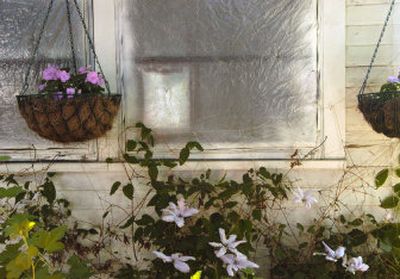Climbing clematis

Climbing vines add the third dimension to any garden. They soften harsh fences and walls, put color in unexpected high places and shade us and our plants from the hot summer sun.
Whatever way you use them, they are an indispensable part of the garden.
There are several vines that grow very well in the Inland Northwest.
Heather Figg and Lauren Moll are familiar with most of them. This husband and wife gardening and nursery team, who operate Clementine’s Nursery from their home, use them all the time in their designs and have stuffed as many of them as possible on their small city lot.
One of their favorites is clematis.
They’ve planted dozens of varieties growing up, around and amongst their other plants, walls and trees.
“We get blooms from April to October,” says Figg. “Out of all the climbing vines, where else can you get that kind of range (of color) on a well-behaved plant?”
One of Figg’s favorite combinations is to let clematis run through her other favorite plant: roses
Clematis comes in a wide range of colors from pinks to yellow to dark purples and reds and almost everything between. Add this to their ability to bloom from spring to fall, and it makes them hard to beat.
But the colorful climbers have a reputation for being hard to grow.
Figg disagrees with that, saying, “They like what every other garden plant likes: good soil, good mulch, even water.”
Clematis is relatively care-free except for problems related to wilt, a fungal stem rot and leaf spot that seems to affect the large-flowered varieties the most. Symptoms of this include a sudden wilting of stems and leaves, which then turn black down to the soil line.
The usual treatment is to remove the affected stem below the wilted section or even below the soil line.
To minimize the chance for wilt, you should handle your clematis carefully, especially when planting, taking care not to crack the stems.
“If you crack the stems when you are planting, there is a chance of wilt getting in (through the cracks),” says Figg.
Figg also recommends planting them deep.
“You want to get one or two sets of leaf nodes underground,” she says. “That is because if clematis does get wilt, it can come back from the nodes under the ground.”
This also helps to keep the roots cool and moist, a must for clematis to thrive.
While clematis is Figg and Moll’s favorite vine, it isn’t the only vine they like to grow.
Here are a few of their other favorites:
Climbing hydrangea. This is a vining form of the familiar hydrangea plant. It has the usual hydrangea leaves attached to woody stems that climb by anchoring themselves to rough surfaces with hairy rootlets.
“I like it for its winter and summer interest,” says Figg. By summer its shiny green leaves add texture while its white flowers add bold color high on a structure. In winter its woody branches make an interesting pattern.
It’s hardy to Zone 4 and prefers sun, with a little afternoon shade.
Wisteria. Wisteria floribunda, the Japanese wisteria, is Figg’s favorite. It is hardier than the more common Chinese wisteria, and it still climbs and drapes its airy green leaves like its cousin, but its flowers tend to be more purple-blue.
All wisteria need a sunny place with a little afternoon shade, fertile, evenly moist soil and stout supports to grow on. It can take several years for a plant to begin blooming.
Porcelainberry vine (Ampelopsis brevipedunculata). This one can grow to 10 to 20 feet on a sunny or partially shaded wall or trellis. While its flowers are inconspicuous, it produces a late summer crop of porcelainlike white, blue, green, pink, turquoise, light blue, black and lavender berries borne in clusters.
It’s somewhat drought tolerant and attractive to hummingbirds.
Trumpet vine. Also known as trumpet creeper, it is a large, woody vine that can grow to 25 to 30 feet. It is perfect for that screen or large ugly fence. It can grow in partial shade or sun (blooms better in sun) in almost any soil under both moist and dry conditions.
In midsummer, it is covered with trumpet-shaped flowers in yellow, orange or red.